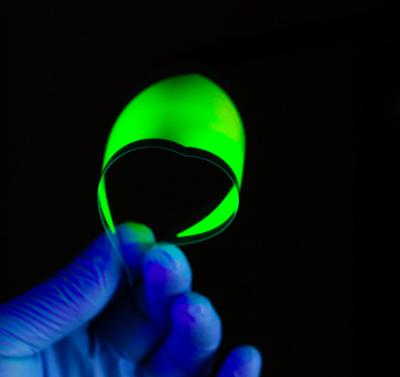Helio Display Materials, based in the UK, was spun-off from both Oxford and Cambridge University, to commercialize photoluminescent and electroluminescent perovskite-based materials for the display industry.

Following is an interview with Helio's CEO, Simon B. Jones, discussing the company's technology and business.
So first of all, can you tell us a bit about Helio's mission and technology?
Helio Display Materials (Helio) is creating proprietary materials for a new generation of brighter and more colourful displays that use significantly less power. The greatly improved colour reproduction that they make possible will help transform our entertainment and work lives as our viewing experiences take a big step closer to being there in person. Helio's materials can increase LCD power efficiency by 70% making a significant difference to the time between charging for mobile devices and to reducing carbon emissions (TVs are responsible for about 4% of residential electricity consumption).
We understand that your first focus is to commercialize photoluminescent perovskite materials. Can you tell us more about that? Will these be quantum-dots like materials?
Yes, our first priority and current focus is to commercialise photoluminescent perovskite materials for displays although we are seeing other potential applications too.
Downconversion of blue light is used in LCDs, and also in future OLEDs and MicroLEDs. How will your PL perovskite compare to current solutions, QDs and Phosphors?
Perovskites have extremely narrow emission spectra which are defined by their chemical composition. This enables them to exceed the colour gamut of indium phosphide (InP) quantum dots and match that of cadmium-based quantum dots whilst being simpler to manufacture. The greatest impact on efficiency and colour can be made with 'in-pixel' architectures, and in this scenario high absorption is important to prevent leakage of the blue light. Perovskites have around five times higher absorption than InP quantum dots which leads to significantly thinner layers, lower cost production processes and less material usage.
One of the advantages of perovskite materials is the ability to be deposited in soluble processes - do you see the possibility of ink-jetting these materials for example? Is that commercially viable?
We will be supporting ink-jet printing processes as well as more established industrial coating and patterning methods. To be successful in the display industry, we strongly believe you need to be working with established supply chains and processing methods as much as possible. So, Helio will support a range of production scenarios, potentially working with different partners in each case.
MicroLEDs is a promising emerging display technology, and many architectures use blue microLEDs with QDs to achieve full color. Will your materials be adopted to microLED devices?
Yes, we are excited by the prospects for microLEDs and have active customer discussions in this area. It is very rare to be able to bring a technology to market that is relevant to the major incumbent solutions (LCD and OLED) as well as potentially disruptive new technologies (microLED)!
When do you see your materials being available for adoption in industrial LCD and OLED production?
We expect to be sampling materials from Q1 2021 and shipping volumes from early 2024.
Helio is also developing electroluminescent perovskite LEDs - which can be used to create truly emissive perovskite displays. Can you tell us what is the current status of that research?
Electroluminescent perovskite materials have rapidly reached comparable quantum efficiencies to OLED, however there is still some way to go to reach the stability and lifetime requirements of consumer products. This is therefore the current focus of our research working closely with our academic partners.
How will such PeLED displays compare to current OLED or microLED displays? In terms of efficiency and properties, but also in terms of production processes?
Electroluminescent perovskite materials promise higher efficiency and colour gamut than OLED. One factor in improved efficiency is 'photon recycling' which is where photons that aren't extracted in the first instance are re-absorbed and re-emitted, hence being given another chance to escape. This effect could be optimised to push external efficiencies towards 100%.
Will the PeLEDs be compatible with current OLED processes and material stacks?
Maximising this compatibility is a key development goal. One very interesting property of perovskites vs. quantum dots is that they can potentially be vacuum deposited, offering the prospect of using manufacturing equipment that is already in place.
When do you see PeLEDs being ready for commercialization?
We expect active commercialisation to be in the 5 year time frame.
We know that most perovskites use lead - are your materials lead-free?
The highest performing perovskites today contain lead but the level will be low and well within the limits set by RoHS which is the relevant de-facto global standard.
Helio was established by world-class researchers from both Oxford and Cambridge Universities (it is the world's first startup to be spun-off from both universities). Can you tell us a bit on how that came to be, and how are you combining the two leading research teams?
Prof. Henry Snaith gained his PhD in Prof Richard Friend's group in Cambridge. Having moved to Oxford and discovered that perovskites have excellent semiconductor properties, Henry realised that they would be interesting for light-emitting applications including displays. As Richard is a founding father of polymer OLEDs, Henry got in touch and proposed a cooperation in the area of light emitting perovskites. And 'the rest is history…' as they say!
Thank you Simon, I wish you and Helio the best of luck!



